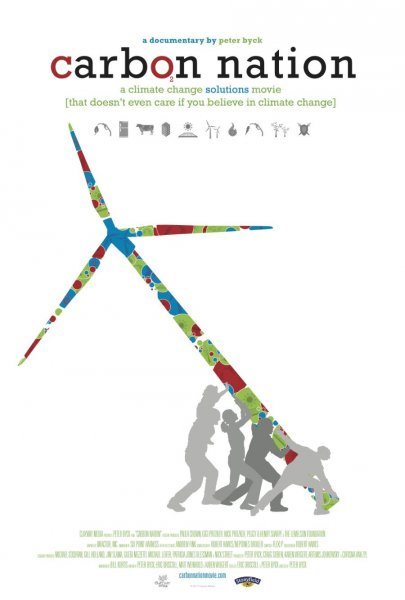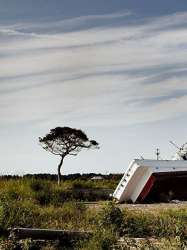Carbon Nation is a american film of genre Documentary released in USA on 11 february 2011
Carbon Nation (2011)

If you like this film, let us know!
- Infos
- Casting
- Technical infos
- Photos
- Videos
- Film quotes
- Characters
- Music
- Awards
Released in USA 11 february 2011
Length 1h26
OriginUSA
Genres Documentary
Themes Environmental films, Documentary films about environmental issues, Documentary films about technology, Disaster films
Rating68%










Carbon Nation is a 2010 documentary film by Peter Byck about technological- and community-based energy solutions to the growing worldwide carbon footprint. The film is narrated by Bill Kurtis. ASIN: B0055T46LA (Rental) and B0055T46G0 (Purchase).
Rather than highlighting the problems with use of fossil fuels, Carbon Nation presents a series of ways in which the 16 terawatts of energy the world consumes can be met while reducing or eliminating carbon-based sources. It contains optimistic interviews with experts in various fields, business CEOs, and sustainable energy supporters to present a compelling case for change while having a neutral, matter-of-fact explanation.
Among those interviewed are Richard Branson, former CIA Director R. James Woolsey, Earth Day founder Denis Hayes and environmental advocate Van Jones.
Much of the content of the film consists of interviews, some are listed above. The list of interviewees also includes
Lester R. Brown President, Earth Policy Institute
Sean Casten President & CEO, Recycled Energy Development
Ralph Cavanagh Lead Attorney, NRDC
Bob Fox, Partner Cook+Fox Architects
Thomas Friedman, Author & NY Times Columnist
Eban Goodstein Economic Professor, Lewis and Clark College
Gary Hirshberg Chairman, President, and CEO of Stonyfield Farm
Sadhu Aufochs Johnston Chief Environmental Officer, City of Chicago
Amory B. Lovins Chairman & Chief Scientist, Rocky Mountain Institute
Joel Makower Executive Director, GreenBiz.com
Edward Mazria Executive Director, Solar Richmond
Arthur H. Rosenfeld Commissioner, California Energy Commission
Comments
Leave comment :
Suggestions of similar film to Carbon Nation
There are 8969 with the same cinematographic genres, 2813 films with the same themes (including 17 films with the same 4 themes than Carbon Nation), to have finally 70 suggestions of similar films.If you liked Carbon Nation, you will probably like those similar films :

Dams: The Lethal Water Bombs (2011)
, 21minutesDirected by Sohan Roy
Genres Documentary
Themes Environmental films, Documentary films about environmental issues, Documentary films about historical events, Documentary films about technology, Disaster films
Rating72%





The Banqiao Dam in China, with its 492 million cubic meters of water, has a similar capacity to the Mullaperiyar Dam, with 443 million cubic meters. When it was destroyed by torrential rains in 1975, it claimed the lives of 250,000 people. This documentary is based on the possibility of a similar disaster happening to the Mullaperiyar Dam in India.

Genres Documentary
Themes Environmental films, Seafaring films, Transport films, Documentary films about environmental issues, Documentary films about historical events, Documentary films about nuclear technology, Documentary films about technology, Disaster films, Films about earthquakes
Rating67%





Surviving the Tsunami brings together social, environmental, and personal perspectives of the national catastrophe of the Fukushima nuclear meltdown. In the documentary, Kyoko Miyake travels back to her hometown in Namie, Fukushima, to revisit her old life and assess the trauma still lingering from the disaster. She revisits Namie, her mother's hometown and meets the people who depended on the success of the nuclear plant for their livelihood. The film also follows Bunsei Watanabe and Kyoko Miyake's Aunt Kuniko, two people who hope for the rejuvenation of Namie, despite the disaster that has occurred. Despite having lost family, friends, and jobs due to the meltdown and subsequent fear of the contamination zone, these two individuals are determined to rebuild their towns and neighborhoods and bring back the sense of community they once had. The film follows the residents of Namie, with emphasis on the experiences of Aunt Kuniko, as they come to terms with the reality of living in or near the "radiation zone" left in the wake the plant's nuclear meltdown. Surviving the Tsunami offers a different perspective on Japanese culture, national identity, human adaption, and global nuclear energy and proliferation.

3.11: Surviving Japan (2013)
, 1h30Directed by Simon Hilton
Genres Documentary
Themes Environmental films, Seafaring films, Transport films, Documentary films about environmental issues, Documentary films about historical events, Documentary films about nuclear technology, Documentary films about technology, Disaster films, Films about earthquakes
Rating81%





The film spans from March 11, 2001 to September 19, 2011, starting with Noland's own experience in the Tōhoku Earthquake and tsunami, Fukushima Daiichi nuclear disaster followed by volunteer activities in Ofunato

Chernobyl Heart (2003)
, 39minutesOrigin USA
Genres Documentary
Themes Environmental films, Documentary films about environmental issues, Documentary films about historical events, Documentary films about nuclear technology, Documentary films about health care, Documentary films about technology, Disaster films
Rating77%





La réalisatrice voyage à travers l'Ukraine et la Biélorussie et observe les effets de la catastrophe nucléaire de Tchernobyl. De nombreux enfants souffrent de problèmes cardiaques, ainsi que de sévères problèmes liés aux radiations.

The Russian Woodpecker (2015)
, 1h20Origin USA
Genres Documentary, Historical
Themes Environmental films, Documentary films about environmental issues, Documentary films about historical events, Documentary films about nuclear technology, Documentary films about technology, Disaster films
Rating66%





The films focuses on Fedor Alexandrovich's research into the cause of the Chernobyl nuclear disaster in Ukraine and its potential connection to a Soviet Cold War-era structure, the Duga over-the-horizon radio antenna. His investigation is interrupted and impacted by the 2014 EuroMaidan uprising, which eventually led to the ouster of the pro-Russian president Viktor Yanukovych.

spOILed (2011)
, 1h30Origin USA
Genres Documentary
Themes Environmental films, Documentary films about environmental issues, Documentary films about technology, Disaster films
Rating66%





Spoiled begins investigating energy myths by asking if people today believe we are "addicted" to oil and if oil is destroying our lives the way other addictions do. The energy movie documentary explores human relationship to oil addiction, and reveals a pattern of misinformation, disinformation, and deception about energy myths.
 , 40minutes
, 40minutesOrigin USA
Genres Documentary
Themes Environmental films, Documentary films about business, Documentary films about environmental issues, Documentary films about historical events, Documentary films about technology, Disaster films
Rating57%






The Hand of Franklin (2014)
Genres Documentary
Themes Environmental films, Seafaring films, Transport films, Documentary films about environmental issues, Documentary films about technology, Disaster films

Voices of Transition (2012)
, 1h5Origin France
Genres Documentary
Themes Environmental films, La mondialisation, Films about the labor movement, Documentary films about business, Documentary films about environmental issues, Documentary films about technology, Documentaire sur le monde du travail, Disaster films
Rating75%





Using interviews and overlays of graphics and text, the film presents the current problems facing industrial agriculture. It explores why in the interviewees' view the current industrial model is not up to the task of feeding the world's people. According to the film every calorie of energy contained in a food source currently takes between 10 and 20 calories of crude oil in the production of fertilizers and transportation to produce, leading to a strong dependence of the cost of food on oil prices. As a result of peak oil and increasing oil prices this dependence will lead to ever increasing food prices. According to the film, this dependence already represents a significant weak-spot in the global food supply chain. Additionally, agriculture is already responsible for 40% of greenhouse gas emissions, contributing to climate change. Furthermore, the film argues that the overuse of inorganic fertilizers has been responsible for the loss of soil fertility and threatens the complete loss of usable soil within the next decades through soil erosion and sinking crop yields. These effects, according to the film, can only be partly mitigated by the increased use of those same fertilizers. The loss of workplaces, the concentration of land in the hands of a few (allegedly a farm closes every 23 minutes in France) as well as the dependence on large corporations are enumerated as side effects of the industrialisation of agriculture since the 1920s. Companies, such as Monsanto and Bayer, control everything from seed stock to fertilizers and the necessary chemical mixes for hybrid plants, thereby controlling the entire supply chain. The film argues that this development was supported through subsidies from the World Bank. Interviews with Vandana Shiva, the founder of the Transition Towns movement Rob Hopkins and various agricultural experts serve to argue this viewpoint. The dependence on crude oil is illustrated through the example of the wholesale food market in Rungis.
 Connection
Connection
